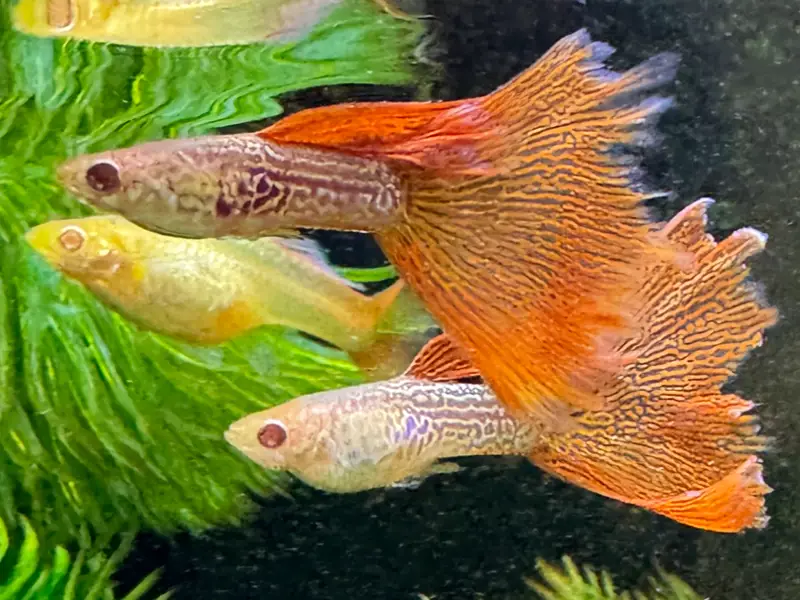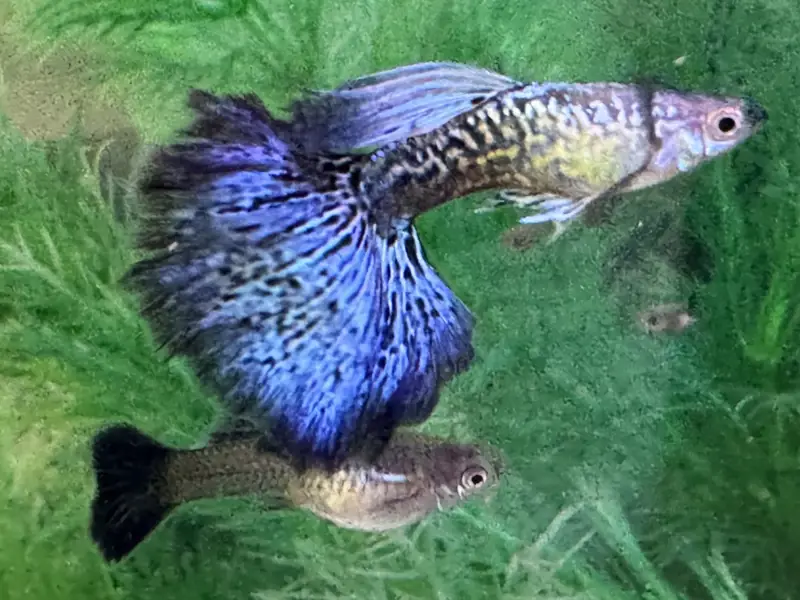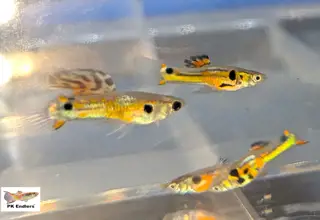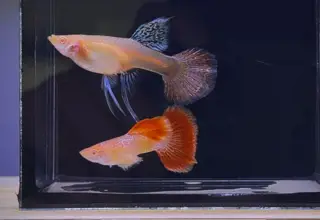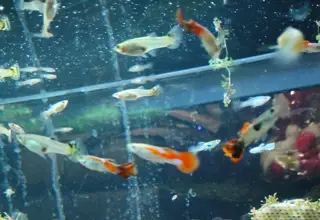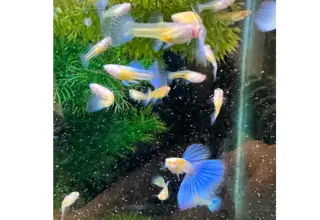Orange Pumpkin Shrimp: Care, Breeding, Tank Mates & More
Posted by Miles Harrison on 02/20/2022
Last updated on 09/26/2022
We use affiliate links and may receive a small commission on purchases.
Orange pumpkin shrimp are a favorite amongst freshwater aquarium hobbyists. Less common than their cherry-shrimp counterpart, the orange pumpkin shrimp makes a great addition to a freshwater fish tank.
These shrimp are exciting to watch, easy to care for, and do great with other tank mates.
They also feed off algae, a great perk if you’re dealing with diatoms or other types of algae in your aquarium.
In this post, we’ll cover everything needed to become well-versed in caring for this wonderful species, and we’ll even answer some frequently asked questions!
Table of Contents
- How much flow should I have for Orange Pumpkin Shrimp?
- What flow rate should I aim for when keeping Orange Pumpkin Shrimp?
- When are Orange Pumpkin Shrimp ready to breed?
- What GH and KH levels are recommended for Orange Pumpkin Shrimp?
- What type of lighting is best for Orange Pumpkin Shrimp?
- What is the best substrate for Orange Pumpkin Shrimp?
- Do Orange Pumpkin Shrimp Molt?
- Where can I buy Orange Pumpkin Shrimp?
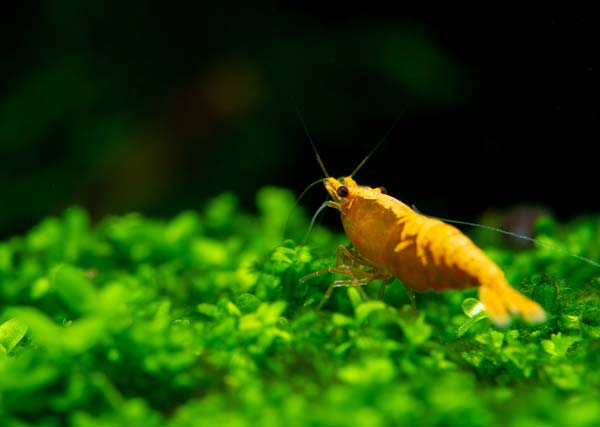
Species Summary
Orange Pumpkin Shrimp are an orange variation of the Neocaridina shrimp species. These shrimp were born from cross-breeding yellow and red cherry shrimp. Constant scavengers, Orange Pumpkins are always looking for new food sources.
Orange pumpkin shrimp are easy to care for and can live up to 3 years..
Hobbyists will enjoy their orange color, which is graded, as their color provides a nice contrast to common aquatic plants and substrates.
With ancestry that originates from Taiwan, this low-maintenance species is one of our favorite variations of the species.
January's Giveaways on Light Fish
Appearance
These shrimp have a striking appearance. Reaching an adult size of about one-and-a-half inches, healthy orange pumpkin shrimp will have a vibrant color.
Female orange pumpkin shrimp tend to be a bit more opaque in color, while males might be a bit more translucent. Male shrimp may also have a speckled body, to some, this may look like a disease, such as white ich, but rest assured this is just a common color pattern amongst males.
Pregnant female orange pumpkin shrimp will also tend to have larger bodies. If examined closely, you can even see eggs on the underbelly of this interesting species.
It’s worth mentioning, that just because an orange pumpkin shrimp does not have a deep-orange coloration, does not necessarily mean the shrimp might be unhealthy. Variations of Neocaridina species are often graded by breeders. We’ll discuss this in more detail below!
🛒 Shop Freshwater Fish on Light Fish
Color Grading
Pumpkin shrimp are often sold under the same grading system as related red cherry shrimp. Although there are fewer variations then the cherry, the grading system is as follows:
Orange Pumpkin Shrimp Grade: This is the lowest grade for orange pumpkin shrimp. Shrimp of this grade are mostly translucent but might display some orange spots on their bodies. If you’re looking for affordable orange pumpkin shrimp, then this grade is for you, as it’s the cheapest grade offered for this species.
Sakura Grade Orange Pumpkin Shrimp: Sakura Grade Orange Pumpkin Shrimp have much more orange coloration than the Orange Pumpkin Grade. Shrimp of this grade are slightly more expensive than the previous grade, but not as expensive as the A grade.
A Grade Orange Pumpkin Shrimp A Grade Orange Pumpkin Shrimp are the highest quality pumpkin shrimp available. They have solid orange bodies and bright coloration. Shrimp of this quality are typically the most expensive grade.
Orange Rili Shrimp Orange Rili shrimp are a unique grade. Beginner hobbyists might think their coloration is undesired, however, the opposite is true. Orange rilis have orange bodies with a clear translucent band, called the “rili pattern”. This unique pattern makes them one of the most sought-after pumpkin shrimp available.
Lifespan
Orange Pumpkin Shrimp have a relatively short lifespan. These shrimp typically live for about 2-3 years in captivity. You’ll want to ask your breeder or local fish store the age of the shrimp when purchasing. In some cases, these shrimp may be purchased as adults.
As with all shrimp species, water quality and diet have a direct correlation to lifespan. You’ll want to maintain pristine water conditions, and feed an optimal diet to ensure your orange pumpkin shrimp can live their longest lives possible.
General Care
Similar to Red Cherry Shrimp, Orange Pumpkin shrimp are low maintenance. These shrimp are hardy and adapt to a wide range of tank water conditions. Orange pumpkins can do well in both hard and soft water.
These shrimp can go long periods without direct feeding. In a planted aquarium, these shrimp will even adapt well to CO2-injected conditions!
Tank Size
Before purchasing this species, you’ll want to make sure you have an aquarium that’s at least 2 gallons in size. One of the best parts about owning Orange Pumpkin Shrimp are their minimal tank requirements.
These shrimp will do well in an aquarium of virtually any size!
Water Parameters
You’ll want to introduce Orange Pumpkin Shrimp to an established aquarium. Ammonia and Nitrite levels should remain at a consistent 0ppm.
Orange Pumpkin Shrimp are a bit more tolerant to subtle changes in water chemistry compared to other species like Bee Shrimp. However, that does not mean you can allow dangerous accumulations of ammonia or nitrite to build up in the water column. You’ll want to perform 40% bi-weekly water changes to keep water chemistry levels in balance.
Two of the most important parameters to monitor when keeping shrimp are GH (General Hardness) and KH (Carbonate Hardness).
You’ll want to test your water supply to determine if you have safe GH and KH levels. Luckily, Orange Pumpkin Shrimp are not as picky compared to other shrimp species when it comes to GH and KH.
As a guideline, Orange Pumpkin Shrimp do well with a GH range between 4-8GH, and a KH range between 3-15KH.
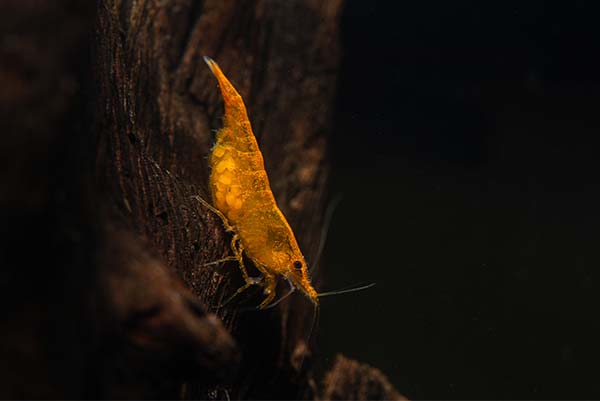
Setting Up An Aquarium for Orange Pumpkin Shrimp
Luckily for freshwater aquarium hobbyists, the tank set up for Orange Pumpkin Shrimp is the same whether or not you plan on keeping them in a shrimp-only tank, or in a community tank with fish or other invertebrates.
First, you’ll want to add some sort of substrate. We recommend eco-complete . This nutrient-rich substrate is great for aquatic plants and is also fine enough where you can anchor any sort of hardscape, such as rocks, stones, or driftwood.
Next, you’ll want to add a heater. Orange Pumpkin Shrimp tend to be more active in warmer temperatures, similar to their native habitat. A heater such as this flat heater from aqueon would do great in a 5-gallon tank. You’ll want to choose a heater that is recommended for your aquarium size.
Most importantly, you’ll want to provide plenty of hiding spots. Orange Pumpkin Shrimp will prefer hanging out amongst plants or hiding out in caverns made of stones or driftwood.
Although these shrimp will do just fine if they’re the only tank inhabitant, if you plan on keeping these shrimp with fish, you’ll need to provide hiding spots. Aquarium fish may mistake these shrimp as a potential meal. The stress the shrimp will experience by being a potential meal is enough to prove fatal for Orange Pumpkin Shrimp!
Filtration Guidelines
Now, let’s discuss filtration. Orange Pumpkin Shrimp will do well with a HOB (hang-on-the-back) filter , or a Canister filter.
These shrimp are not picky when it comes to filtration. Any of the previously mentioned filters for your given tank size should be sufficient.
Since these shrimp are so small in size, you may want to invest in a foam mesh that can be used to cover your filter inflow. If the filter inflow is strong, covering it with a foam mesh will eliminate any risk of having your shrimp fall victim to the strength of the inflow current.
Water Changes
Shrimp, just like many fish species, are susceptible to the dangers of sudden changes in water chemistry.
When keeping Orange Pumpkin Shrimp, you’ll want to make sure your water changes are more gradual. Instantly changing the water chemistry by doing a large water change might shock your shrimp.
When performing water changes with Orange Pumpkin Shrimp, we recommend slowly acclimating the shrimp over a 30-minute period. Using a siphon such as the Python No Spill Clean and Fill will make this process easy.
Temperament and Behavior
Orange Pumpkin Shrimp are a very peaceful shrimp species. Typically you will see this shrimp grazing on algae growing along the substrate.
These shrimp are quite active when they’re healthy. They should actively move around the aquarium while searching for new food sources.
Although they tend to be a bit more active at night, this species is quite fun to watch in a freshwater aquarium.
Food & Diet
Orange Pumpkin Shrimp will accept most foods and will enjoy nutrient-enriched fish flakes, algae wafers, and sinking shrimp pellets.
These shrimp will also consume hair and dust algae, a nice perk to owning this wonderful species!
Since Orange Pumpkin Shrimp will happily consume algae or leftover food sources, they are capable of going 2-3 days without direct feeding. However, we recommend feeding at least once a day. Daily feedings will guarantee your shrimp have plenty of available food sources.
Tank mates
Given the peaceful nature of Orange Pumpkin Shrimp, they will do well with many other peaceful species.
Other shrimp such as Red Cherry, Sunkist, Crystal Red, and Orange Rili’s are all potential tank mates for the Orange Pumpkin Shrimp.
Aquarists will enjoy pairing these shrimp with small peaceful freshwater fish. Cardinal tetras, white cloud minnows, neon tetras, green neon tetras, guppies, and endlers make for great tank mates.
As long as plenty of hiding spots are available for these shrimp, they can co-exist comfortably with many species.
We advise against keeping these shrimp with betta fish, or other large freshwater fish that may mistake Orange Pumpkin Shrimp as a meal.
You’ll want to be sure you have an aquarium that’s large enough to house different types of inhabitants. If Orange Pumpkin Shrimp do not have enough room, they will grow stressed, and their immune systems will weaken.
Breeding
Orange Pumpkin Shrimp will readily breed in a freshwater aquarium. In fact, breeding is a sign that your water conditions have been kept in excellent shape!
There is not much you need to do to breed this species. If you have an aquarium with plenty of hiding spots, and a male and female pair of Orange Pumpkin Shrimp, you have a good chance that breeding will occur.
You’ll notice when a female pumpkin shrimp is pregnant, as she will have an expanded underbelly. If you look close enough, you can even see the eggs!
The most difficult part of Orange Pumpkin Shrimp breeding is keeping baby shrimp alive long enough to turn into adults.
These young shrimp need to have a constant supply of food to survive, and if you plan on keeping a community tank with fish or freshwater amphibians, baby shrimp will be a sought-after meal.
However, if you can successfully raise these shrimp from babies to adults, you can pat yourself on the back, as you’ve successfully bred Orange Pumpkin Shrimp!
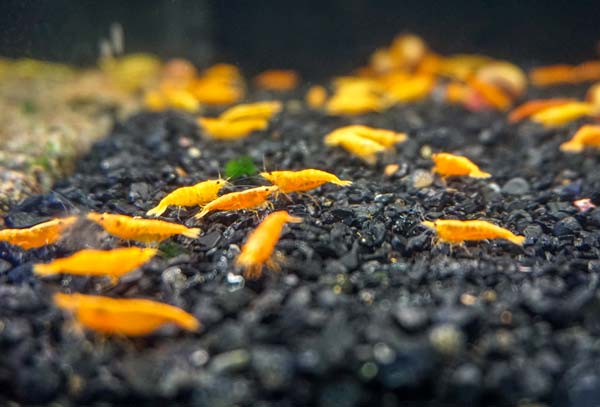
Frequently Asked Questions
How much flow should I have for Orange Pumpkin Shrimp?
A good current, with a slight ripple across the surface is ideal for these shrimp. Having good flow throughout the aquarium promotes good gaseous exchange, and raises oxygen levels. Typically, Orange Pumpkin Shrimp will move in and out of the current.
What flow rate should I aim for when keeping Orange Pumpkin Shrimp?
10X turnover of the tank volume is an ideal target flow rate. Orange Pumpkin Shrimp will seek refuge amongst plants or other hardscape objects if the flow is too strong.
When are Orange Pumpkin Shrimp ready to breed?
Orange Pumpkin Shrimp are easy to breed when they reach sexual maturity, around 4-6 months of age. Water parameters should be stable, and temperatures should be between 70-80°F. Soon after a female molts, she will release pheromones to attract a male. After breeding, the female will carry the fertilized eggs.
What is the best substrate for Orange Pumpkin Shrimp?
Orange Pumpkin Shrimp do well with most aquarium substrates. Seachem Flourite CaribSea Eco-Complete 20-Pound Planted Aquarium , and Aqueon Plant and Shrimp Substrate are excellent options for an Orange Pumpkin Shrimp tank.
What GH and KH levels are recommended for Orange Pumpkin Shrimp?
These Shrimp can adapt to a wide range of GH and KH conditions. As a guideline, Orange Pumpkin Shrimp do well with a GH range between 4-8GH, and a KH range between 3-15KH.
What type of lighting is best for Orange Pumpkin Shrimp?
Shrimp do well when the lights are on for about 6-10 hours a day. These shrimp are more active at nighttime. They do not have any requirements regarding light intensity.
Do Orange Pumpkin Shrimp Molt?
Orange Pumpkin Shrimp molt frequently. It is common to see exoskeletons in the aquarium. Molting is necessary for shrimp, aiding in their growth and reproductive system. Providing plants and other hiding spots will provide a safe space for Orange Pumpkin Shrimp to molt.
Where can I buy Orange Pumpkin Shrimp?
Orange Pumpkin Shrimp are occasionally sold on websites such as Light Fish and LiveAquaria .
In Summary
We’ve covered a lot about this interesting shrimp variation. Orange Pumpkin Shrimp are some of the easiest to take care of shrimp species available in the freshwater aquarium hobby.
Hopefully, after reading this post, you’ll be more than prepared to take care of this eye-catching shrimp.
Orange Pumpkin Shrimp are one of our favorite color variations of Neocaridina shrimp, and we’re sure you will love watching them swim throughout the aquarium as much as we do!
January's Giveaways on Light Fish
